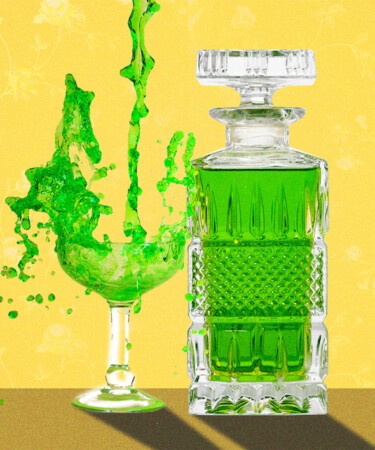If you’ve ever ordered a Sazerac at a bar, you may recall seeing the bartender splash some bright green liquid into your glass before dramatically pouring it all out. This technique, known as an absinthe rinse, might seem futile — and maybe even a bit wasteful — but ultimately, it can add some serious complexity to the final cocktail.
So, how much can absinthe actually contribute to a drink from its brief contact with your glass? We asked William Elliott, bar director at Brooklyn-based absinthe bar Maison Premiere, to break down the true purpose of the absinthe rinse.
In order for a spirit to be legally categorized as absinthe, it must be made with the “holy trinity” of botanicals: grand wormwood, fennel bulb, green anise seed. These plants impart herbaceous notes of mint, green herbs, and anise, the last of which is commonly described as a licorice-like aroma. This intensity of flavor, along with the spirits’ high alcohol content, can easily overwhelm a drink if added directly.
“Absinthe is incredibly potent, typically lying between 60 and 70 percent alcohol,” Elliott explains, “and that’s why it is always meant to be diluted in a cocktail or served in a traditional absinthe drip.” So when judiciously employed as a quick rinse, the essence of absinthe clings to the sides of the glass and wafts up to subtly tickle the drinker’s senses. Elliot remarks that the hint of absinthe “makes for a beautiful bouquet of herbs and botanicals, adding great depth and detail to the drink.”
In addition to the fragrant aromas you get from the herbaceous liqueur, Elliot explains that absinthe can add “a layer of slight bitterness to a cocktail, giving it an anchor in the spice-bound notes.” He adds that that bitterness can also help offset sweetness. The Sazerac is a great example of this: The classic New Orleans-born riff on the Old Fashioned is crafted with rye whiskey, Demerara syrup, Peychaud’s Bitters, and a lemon twist. A quick absinthe rinse before pouring in the other ingredients provides balance and a perfumed lift to what can otherwise be considered an overly boozy cocktail.
As an absinthe bar, Maison Premiere takes its absinthe rinses quite seriously, and actively avoids wasting any of the liquid. Elliot recalls having an “aha!” moment at the bar while dumping excess absinthe out of a glass. “Why would I throw away absinthe at an absinthe bar?” he wondered. Granted, the ceremonious throwing of the absinthe post-rinse is part of the legacy of the historic cocktail, but Elliot was driven to repurpose the precious spirit instead. This realization ended up changing the recipe for the bar’s iconic Sazerac.
If you order a Sazerac at Maison Premiere, the first thing the bartender does is fill a rocks glass with crushed ice. Then, they pour in half an ounce of absinthe, allowing the ice to both chill the glass and dilute the absinthe. (Elliot notes that a rinse of straight absinthe can still overpower a cocktail, so he insists on diluting the absinthe in the process.) Once that’s done, the excess absinthe is strained into a tiny glass and presented as a sidecar next to the cocktail, creating a more sensorial absinthe experience.
As for other cocktails that benefit from an absinthe rinse, the Corpse Reviver No. 2 is a popular example. That said, Maison Premiere opts for a few dashes of absinthe as opposed to a rinse in its current iteration of the cocktail. “I think it’s really about personal preference,” Elliot says.
Whether you’re adding it as a rinse, atomizing it over the top, or mixing it into the cocktail itself, absinthe can be incorporated in many ways to satisfy anyone’s personal preference. And if you’re looking to try something new, Elliot suggests trying an absinthe rinse the next time you make a classic Martini. “That kind of herbaceous complexity works perfectly parallel with gin,” he says.
